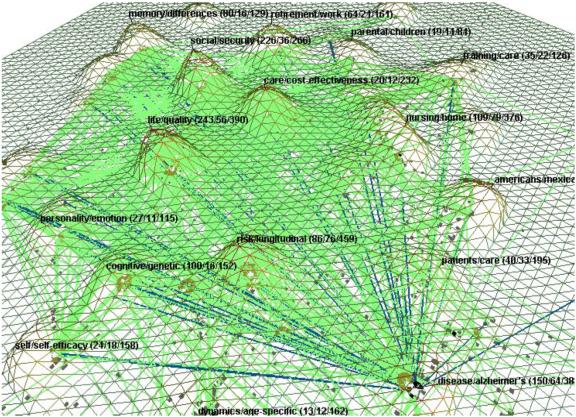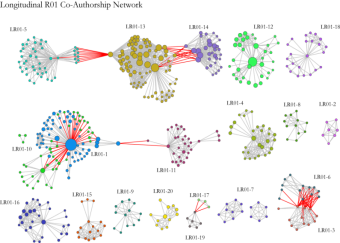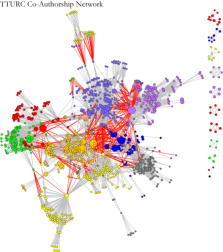6.2.1 Indicator-Assisted Evaluation and Funding of Research: Visualizing the Influence of Grants on the Number and Citation Counts of Research Papers (2003)
By Kevin W. Boyack & Katy Börner (2003)
This article reports research on analyzing and visualizing the impact of governmental funding on the amount and citation counts of research publications. For the first time, grant and publication data appear interlinked in one map. We start with an overview of related work and a discussion of available techniques. A concrete example - grant and publication data from Behavioral and Social Science Research, one of four extramural research programs at the National Institute on Aging (NIA) - is analyzed and visualized using the VxInsight® visualization tool. The analysis also illustrates current existing problems related to the quality and existence of data, data analysis, and processing. The article concludes with a list of recommendations on how to improve the quality of grant-publication maps and a discussion of research challenges for indicator-assisted evaluation and funding of research.
Author supplied linkage patterns (light gray lines) from grants to publications with links highlighted as dark lines for grant 01 P50 AG11715-01.
6.2.2 Mapping Transdisciplinary Tobacco Use Research Centers Publications (forthcoming)
By Angela Zoss & Katy Börner (forthcoming)
This paper reports the results of a scientometric study aimed at evaluating and comparing investigator initiated R01-research and Transdisciplinary Tobacco Use Research Centers (TTURC) funded by the National Institutes of Health (NIH) between 1999 to 2009. Specifically, the study shows the results of a geospatial and topical analysis, a network analysis of collaboration networks, a funding-input vs. publication-output analysis, and a temporal analysis of data trends and coverage. The results were interpreted by tobacco domain experts providing insight into the overall structure and evolution of tobacco research collaborations, interdisciplinary integration, and impact on science as a whole. The study complements efforts that use the very same controlled R01-TTURC dataset in two ways: First, it shows major differences in collaboration patterns and topical coverage of TTURC funded projects. TTURC co-author networks have small world characteristics making them robust to the frequent movement of people in academia while supporting efficient diffusion of information and expertise. Second, TTURC projects by design have a larger topic coverage and wider spectrum of basic to applied research and practice. This is reflected in their topic coverage but also in the ratio of funding-input versus paper-output – TTURC output goes beyond simply producing papers. We conclude with recommendations on how to improve future evaluations of transdisciplinary research centers.
Compare R01 investigator based funding with TTURC Center awards in terms of number of publications and evolving co-author networks.


